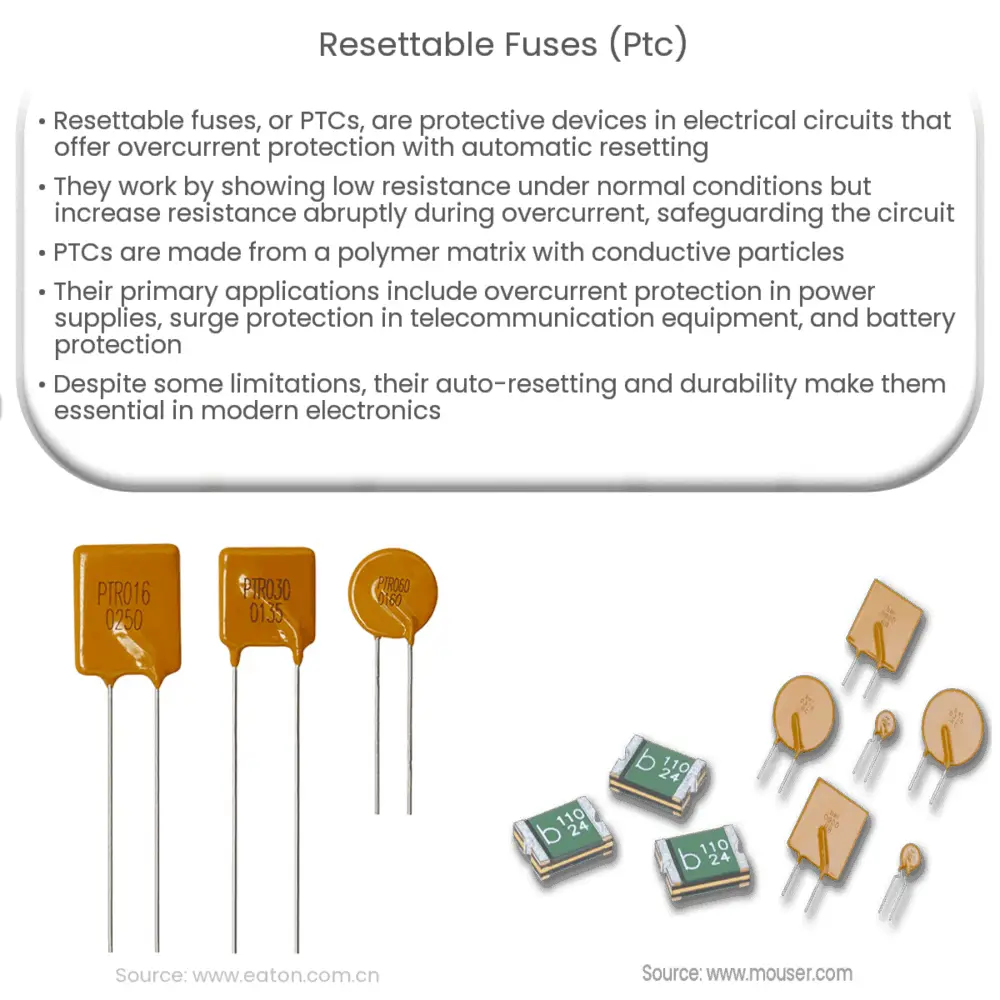Explore the concept of Resettable Fuses or PTCs, their working principle, structure, applications, advantages, and limitations.

Understanding Resettable Fuses (PTC)
Resettable fuses, also known as Polymeric Positive Temperature Coefficient devices (PTCs), represent a category of protective devices used in electrical circuits. PTCs provide overcurrent protection and automatic resetting functionality, making them a practical choice for safeguarding sensitive electronic components.
The Working Principle of PTCs
PTCs primarily operate on the principle of positive temperature coefficient of resistance. When the device is operating normally, it exhibits low resistance, allowing for the free flow of current. However, if the current exceeds a certain threshold, it induces a rise in the PTC’s temperature, causing an abrupt increase in resistance. This drastic change limits the flow of current, offering protection to the rest of the circuit.
- 1Low resistance under normal operation
- 2Abrupt increase in resistance during overcurrent condition
Composition and Structure of PTCs
PTCs are often constructed from a polymer matrix filled with conductive particles. Under normal operating conditions, these particles form a network that allows for the flow of current. When the device heats up due to overcurrent, the polymer expands, disrupting the network and causing a dramatic increase in resistance.
Applications of Resettable Fuses (PTCs)
Resettable fuses find wide-ranging applications in various electronics due to their unique characteristics. Some of their key uses are:
- 1Overcurrent protection in power supplies
- 2Surge protection in telecommunications equipment
- 3Protection of batteries and battery packs
Benefits of Using PTCs
PTCs offer several benefits over traditional fuses. They reset automatically after an overcurrent event, eliminating the need for replacement or manual intervention. Additionally, they are designed to withstand multiple overcurrent events without any degradation in performance, which significantly increases their lifespan and reliability.
This unique blend of functionality and robustness makes resettable fuses an indispensable element in the design of modern electronic systems. The following section will delve deeper into these aspects, shedding light on more advanced concepts surrounding PTCs, including their limitations, the various types available, and factors to consider when choosing a PTC for your application.
Limitations of Resettable Fuses (PTCs)
Despite their numerous advantages, it’s important to be aware of some limitations associated with PTCs. They have a slower response time compared to conventional fuses, which may not be suitable for some applications. Additionally, they do not offer precise control over the tripping current, which can vary depending on ambient temperature and other factors. This unpredictability could pose challenges in highly sensitive applications.
Varieties of PTCs
PTCs come in a variety of forms to suit different applications. Radial leaded PTCs are commonly used in power supplies and telecommunication equipment, while surface mount PTCs are suitable for high-density electronic assemblies. Additionally, there are battery strap PTCs specifically designed for battery protection.
- 1Radial Leaded PTCs
- 2Surface Mount PTCs
- 3Battery Strap PTCs
Choosing the Right PTC
When selecting a PTC for a specific application, it’s essential to consider several factors. These include the device’s operating voltage, the maximum current it can handle, and its trip current rating. Additionally, one should also take into account the ambient operating temperature, as it can influence the performance of the PTC.
Conclusion
Resettable fuses, or PTCs, are an invaluable resource in the electrical and electronic world. They provide excellent overcurrent protection while eliminating the need for manual intervention or replacement after a fault event. This automatic resetting function and durability make PTCs an ideal choice for protecting modern electronic systems.
Despite their limitations, like slower response time and lack of precise control over the tripping current, the benefits and applications of PTCs overwhelmingly outweigh these drawbacks. The variety of PTCs available also means there is likely a PTC suitable for nearly any application.
In summary, the safety, durability, and convenience of PTCs make them a crucial component of electrical and electronic systems. These devices continue to play an increasingly significant role in the future of electronic design and innovation.

